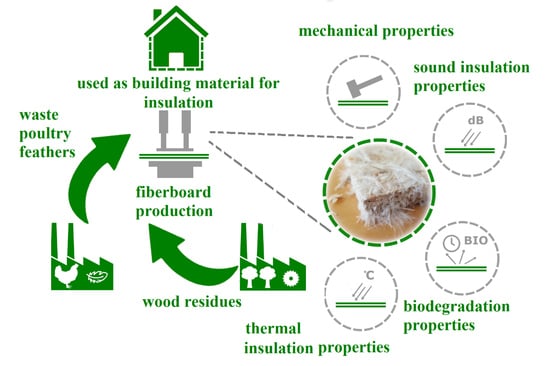Preparation and Characterisation of Waste Poultry Feathers Composite Fibreboards
Abstract
1. Introduction
2. Materials
2.1. Poultry Feathers
2.2. Wood Residues
2.3. Adhesive
3. Methods
3.1. Waste Poultry Feather Cleaning
3.2. Waste Poultry Feather Drying
3.3. Fibreboards’ Preparation
3.4. Mechanical Testing
3.5. Acoustic Analyses
3.6. Biodegradation Measurement (Based on ISO 14855-2)
3.7. Thermal Conductivity Determination
4. Results and Discussion
4.1. Structure and Morphology of Samples
4.2. Mechanical Properties
4.3. Acoustic Properties
4.4. Biodegradation
4.5. Thermal Conductivity
4.6. Additional Costs to Fibreboards’ Production
5. Conclusions
Supplementary Materials
Author Contributions
Funding
Acknowledgments
Conflicts of Interest
References
- Bruinsma, J. Food and Agriculture Organization (FAO). World Agriculture: Towards 2015/2030; Food Agricultural Organization: London, UK, 2003; p. 162. Available online: http://www.fao.org/3/a-y4252e.pdf (accessed on 30 October 2020).
- Marquer, P.; Rabade, T.; Forti, R. Meat production statistics - Statistics Explained, Eurostat. 2014. Available online: https://ec.europa.eu/eurostat/statistics-explained/index.php?title=Archive:Meat_production_statistics (accessed on 30 August 2020).
- Lasekan, A.; Abu Bakar, F.; Hashim, D. Potential of chicken by-products as sources of useful biological resources. Waste Manag. 2013, 33, 552–565. [Google Scholar] [CrossRef] [PubMed]
- Council Directive. Council Directive 1999/31/EC on the landfill. Off. J. Eur. Communities 1999, L182, 1–19. [Google Scholar]
- Dieckmann, E.; Eleftheriou, K.; Audic, T.; Lee, K.Y.; Sheldrick, L.; Cheeseman, C.R. New sustainable materials from waste feathers: Properties of hot-pressed feather/cotton/bi-component fibre boards. Sustain. Mater. Technol. 2019, 20, e00107. [Google Scholar] [CrossRef]
- Staron, P.; Banach, M.; Kowalski, Z.; Staron, A. Hydrolysis of Keratin materials derived from Poultry Industry. In Proceedings of the ECOpole Conference, Jarnoltowek, Poland, 15–18 October 2014; Volume 8, pp. 443–448. Available online: http://tchie.uni.opole.pl/PECO14_2/EN/StaronBanach_PECO14_2.pdf (accessed on 20 October 2020).
- Reddy, N. Non-food industrial applications of poultry feathers. Waste Manag. 2015, 45, 91–107. [Google Scholar] [CrossRef]
- Esparza, Y.; Ullah, A.; Boluk, Y.; Wu, J. Preparation and characterization of thermally crosslinked poly(vinyl alcohol)/feather keratin nanofiber scaffolds. Mater. Des. 2017, 133, 1–9. [Google Scholar] [CrossRef]
- Al-Asheh, S.; Banat, F.; Al-Rousan, D. Beneficial reuse of chicken feathers in removal of heavy metals from wastewater. J. Clean. Prod. 2003, 11, 321–326. [Google Scholar] [CrossRef]
- Sayed, S.; Saleh, S.; Hasan, E. Removal of some polluting metals from industrial water using chicken feathers. Desalination 2005, 181, 243–255. [Google Scholar] [CrossRef]
- Senoz, E.; Wool, R.P. Hydrogen storage on pyrolyzed chicken feather fibers. Int. J. Hydrogen Energy 2011, 36, 7122–7127. [Google Scholar] [CrossRef]
- Rangaraj, V.M.; Edathil, A.A.; Kadirvelayutham, P.; Banat, F.; Vengatesan, M.R. Chicken feathers as an intrinsic source to develop ZnS/carbon composite for Li-ion battery anode material. Mater. Chem. Phys. 2020, 248, 122953. [Google Scholar] [CrossRef]
- Tyagi, A.; Yadav, A.; Sinha, P.; Singh, S.; Paik, P.; Kar, K.K. Chicken feather rachis: An improvement over feather fiber derived electrocatalyst for oxygen electroreduction. Appl. Surf. Sci. 2019, 495, 143603. [Google Scholar] [CrossRef]
- Veerakumar, P.; Salamalai, K.; Dhenadhayalan, N.; Lin, K.C. Catalytic Activity of Bimetallic (Ruthenium/Palladium) Nano-alloy Decorated Porous Carbons Toward Reduction of Toxic Compounds. Chem. – Asian J. 2019, 14, 2662–2675. [Google Scholar] [CrossRef]
- Senoz, E.; Stanzione, J.F.; Reno, K.H.; Wool, R.P.; Miller, M.E.N. Pyrolyzed chicken feather fibers for biobased composite reinforcement. J. Appl. Polym. Sci. 2012, 128, 983–989. [Google Scholar] [CrossRef]
- Wrześniewska-Tosik, K.; Marchut-Mikołajczyk, O.; Mik, T.; Wieczorek, D.; Pałczyńska, M. Mats for removing technical oil contamination. Fibres Text. East. Eur. 2012, 96, 101–106. [Google Scholar]
- Wrześniewska-Tosik, K.; Marcinkowska, M.; Niekraszewi, A.; Dorota, A.; Potocka, T.; Mik, M.; Pałczyńska, M. Fibrous composites based on keratin from chicken feathers. Fibres Text. East. Eur. 2011, 89, 118–123. [Google Scholar]
- Choudary, R.; Krishna, N.N.; Bhargava, N. Study on CFF-Polyester Composites. Mater. Today: Proc. 2018, 5, 8514–8522. [Google Scholar] [CrossRef]
- Choudary, R.; Nehanth, R. Effects of fibre content on mechanical properties of chicken feather fibre/PP composites. Mater. Today Proc. 2019, 18, 303–309. [Google Scholar] [CrossRef]
- Isiaka Oluwole, O.; Avwerosuoghene Moses, O.; Joseph Ajibade, O.; Moshibudi Caroline, K. Evaluation of the mechanical properties of chemically modified chicken feather fibres reinforced high density polyethylene composites. J. Taibah Univ. Sci. 2018, 12, 56–63. [Google Scholar]
- Manral, A.R.S.; Gariya, N.; Bansal, G.; Singh, H.P.; Rawat, A. Computational stress analysis of Chicken Feather Fibre (CFF) with Epoxy-Resin matrix composite material. Mater. Today: Proc. 2020, 26, 2805–2810. [Google Scholar] [CrossRef]
- Sun, M.; Sun, H.; Hostler, S.; Schiraldi, D.A. Effects of feather-fiber reinforcement on poly(vinyl alcohol)/clay aerogels: Structure, property and applications. Polymer 2018, 137, 201–208. [Google Scholar] [CrossRef]
- Pourjavaheri, F.; Mohades, F.; Jones, O.; Sherkat, F.; Kong, I.; Gupta, A.; Shanks, R.A. Avian keratin fibre-based bio-composites. World J. Eng. 2017, 14, 183–187. [Google Scholar] [CrossRef]
- Wang, J.; Hao, S.; Luo, T.; Yang, Q.; Wang, B. Development of feather keratin nanoparticles and investigation of their hemostatic efficacy. Mater. Sci. Eng. C 2016, 68, 768–773. [Google Scholar] [CrossRef]
- Wang, J.; Hao, S.; Luo, T.; Cheng, Z.; Li, W.; Gao, F.; Guo, T.; Gong, Y.; Wang, B. Feather keratin hydrogel for wound repair: Preparation, healing effect and biocompatibility evaluation. Colloids Surfaces B Biointerfaces 2017, 149, 341–350. [Google Scholar] [CrossRef]
- Thonpho, A.; Srihanam, P. Preparation and Characterization of Keratin Blended Films using Biopolymers for Drug Controlled Release Application. Orient. J. Chem. 2016, 32, 1739–1748. [Google Scholar] [CrossRef]
- Pajarito, B.B.; Belarmino, A.J.; Calimbas, R.M.; Gonzales, J.R. Graphite Nanoplatelets from Waste Chicken Feathers. Materials 2020, 13, 2109. [Google Scholar] [CrossRef]
- Asdrubali, F.; D’Alessandro, F.; Schiavoni, S. A review of unconventional sustainable building insulation materials. Sustain. Mater. Technol. 2015, 4, 1–17. [Google Scholar] [CrossRef]
- Acda, M.N. Waste chicken feather as reinforcement in cement-bonded composites. Philipp. J. Sci. 2010, 139, 161–166. [Google Scholar]
- Winandy, J.E.; Muehl, J.H.; Micales, J.A.; Raina, A.; Schmidt, W. Potential of Chicken Feather Fibre in Wood MDF Composites. In Proceedings of the 2nd International Conference on EcoComposites – EcoComp, London, UK, 1–2 September 2003; pp. 1–6. [Google Scholar]
- Taghiyari, H.R.; Majidi, R.; Esmailpour, A.; Samadi, Y.S.; Jahangiri, A.; Papadopoulos, A.N. Engineering Composites Made from Wood and Chicken Feather Bonded with UF Resin Fortified with Wollastonite: A Novel Approach. Polymers 2020, 12, 857. [Google Scholar] [CrossRef]
- Bessa, J.; Souza, J.; Lopes, J.; Sampaio, J.; Mota, C.; Cunha, F.; Fangueiro, R. Characterization of thermal and acoustic insulation of chicken feather reinforced composites. Procedia Eng. 2017, 200, 472–479. [Google Scholar] [CrossRef]
- Strnad, S.; Kreže, T. Poultry feather wastes - optimization of cleaning procedure for new products development. In Proceedings of the International Conference on Innovative Technologies, IN-TECH 2011, Bratislava, Slovakia, 1–3 September 2011; pp. 532–535. [Google Scholar]
- Bratina, B.; Šorgo, A.; Kramberger, J.; Ajdnik, U.; Zemljič, L.F.; Ekart, J.; Šafarič, R. From municipal/industrial wastewater sludge and FOG to fertilizer: A proposal for economic sustainable sludge management. J. Environ. Manag. 2016, 183, 1009–1025. [Google Scholar] [CrossRef]
- ISO 10534. Acoustics—Determination of Sound Absorption Coefficient and Impedance in Impedance Tubes; International Organization for Standardization: Geneva, Switzerland, 1998. [Google Scholar]
- ASTM E1050-90. Standard Test Method for Impedance and Absorption of Acoustical Materials Using a Tube, Two Microphones and a Digital Frequency Analysis System; ASTM International: West Conshohocken, PA, USA, 2008. [Google Scholar]
- ASTM C384-98. Standard Test Method for Impedance and Absorption of Acoustical Materials by the Impedance Tube Method; ASTM International: West Conshohocken, PA, USA, 1998. [Google Scholar]
- Selamet, A.; Ji, Z. Acoustic attenuation performance of circular expansion chambers with extended inlet/outlet. J. Sound Vib. 1999, 223, 197–212. [Google Scholar] [CrossRef]
- Lee, Y.; Ng, C. Sound insertion loss of stiffened enclosure plates using finite element method and the classical approach. J. Sound Vib. 1998, 217, 239–260. [Google Scholar] [CrossRef]
- Karlinasari, L.; Hermawan, D.; Maddu, A.; Bagus, M.; Khrisna Lucky, I.; Nugroho, N.; Sudo Hadi, Y. Acoustical Properties of particleboards made from betung bamboo (Dendrocalamus asper) as building construction material. Biol. Res. 2012, 7, 5700–5709. [Google Scholar] [CrossRef]

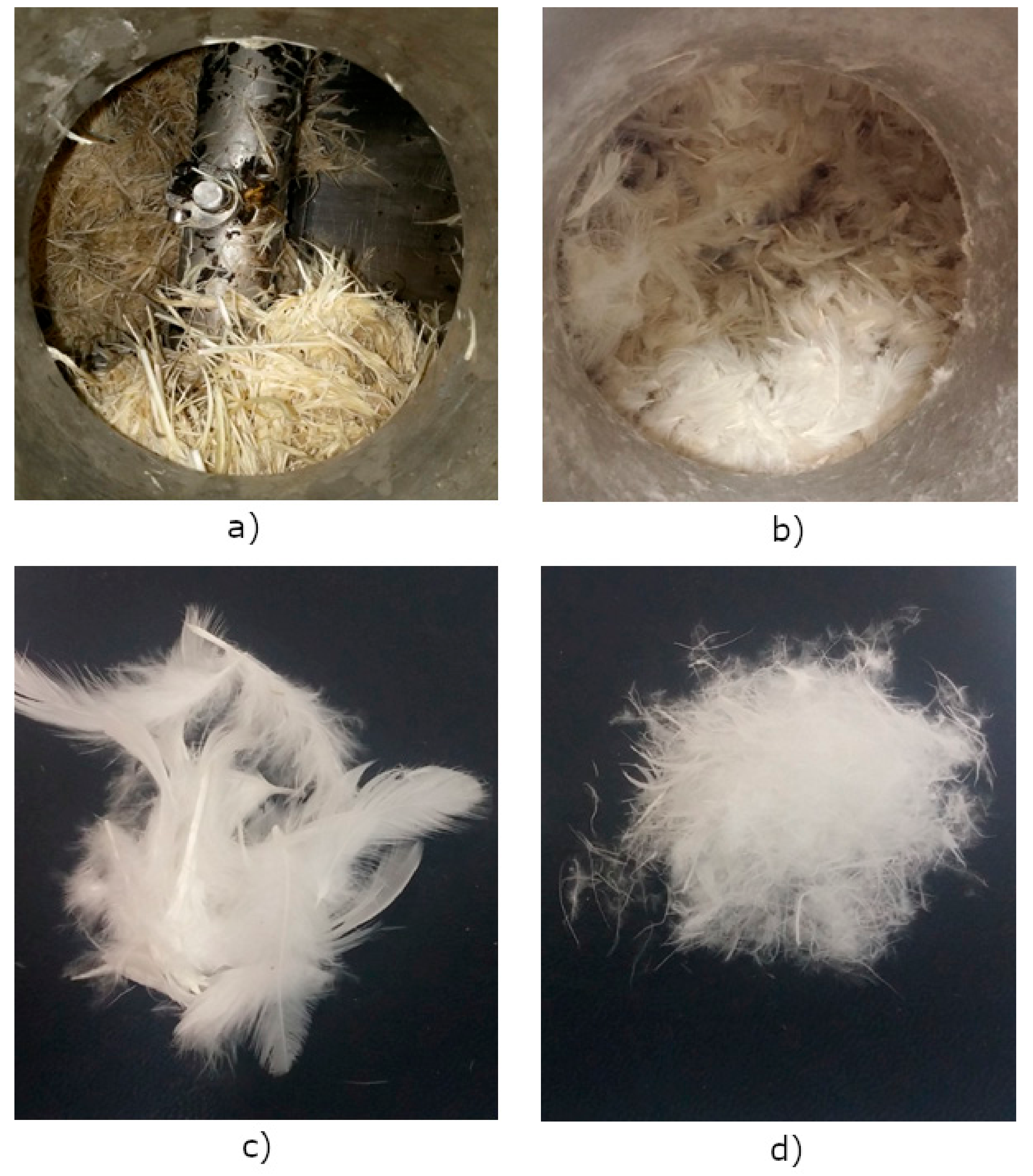
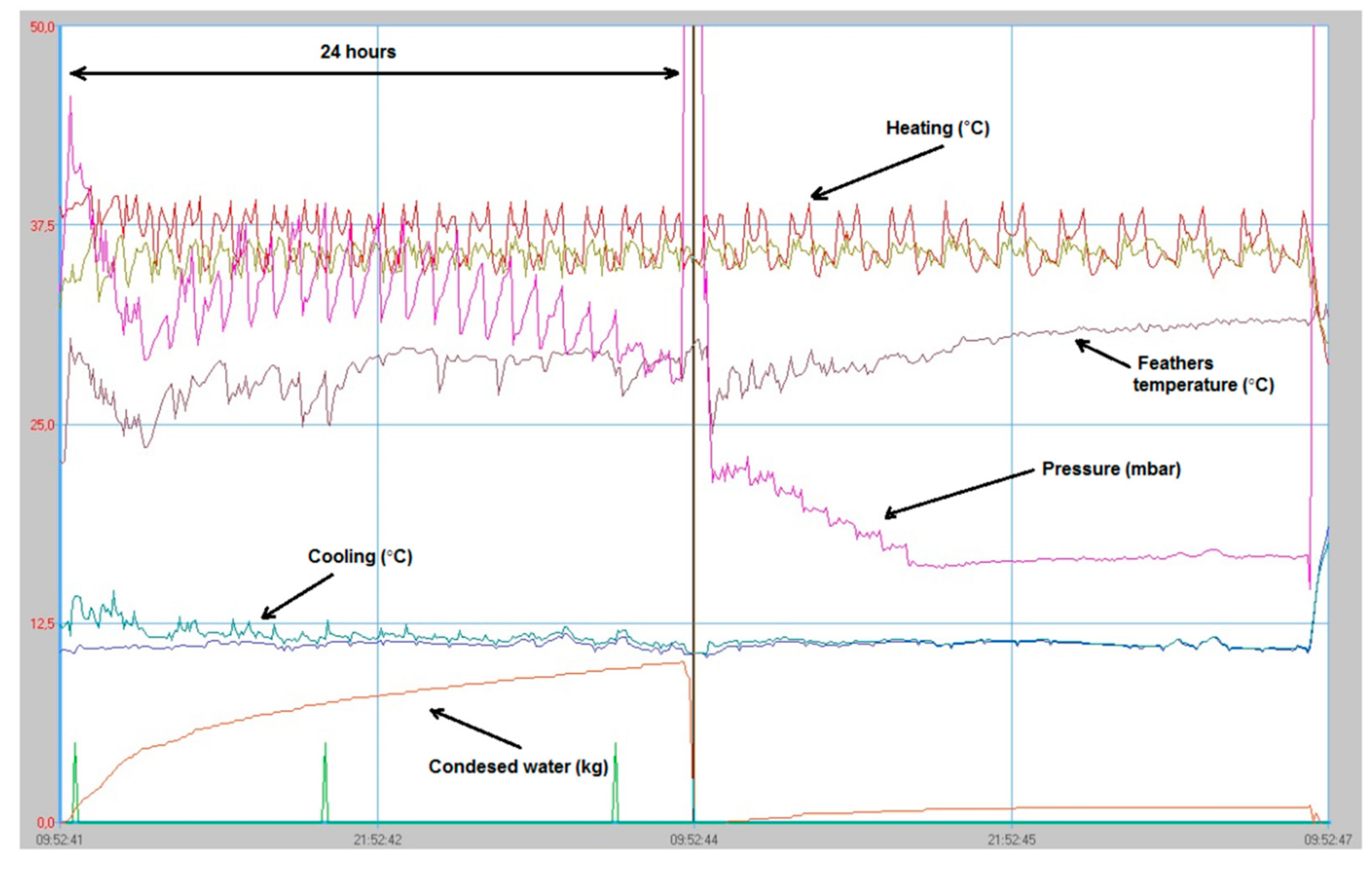


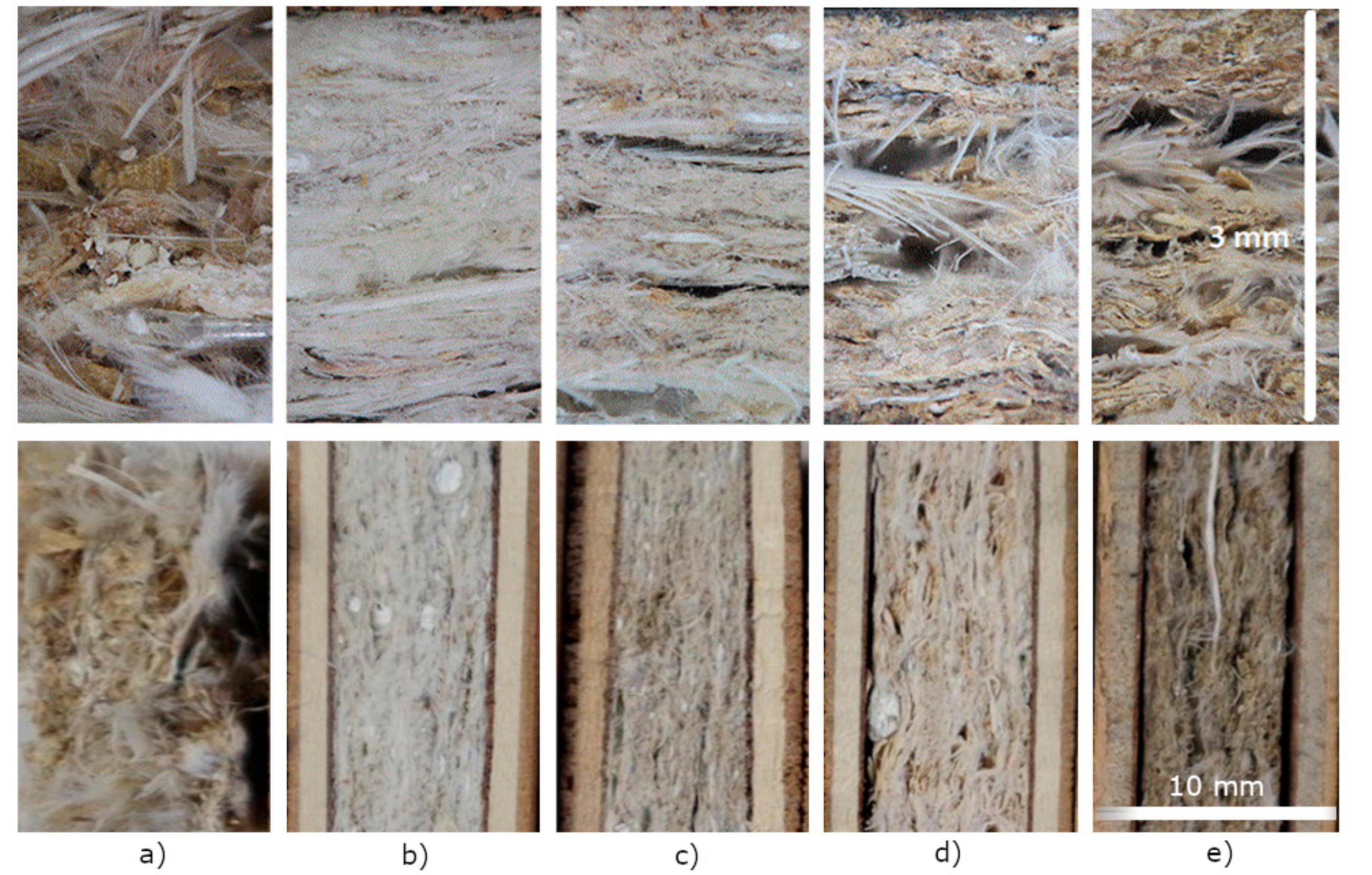
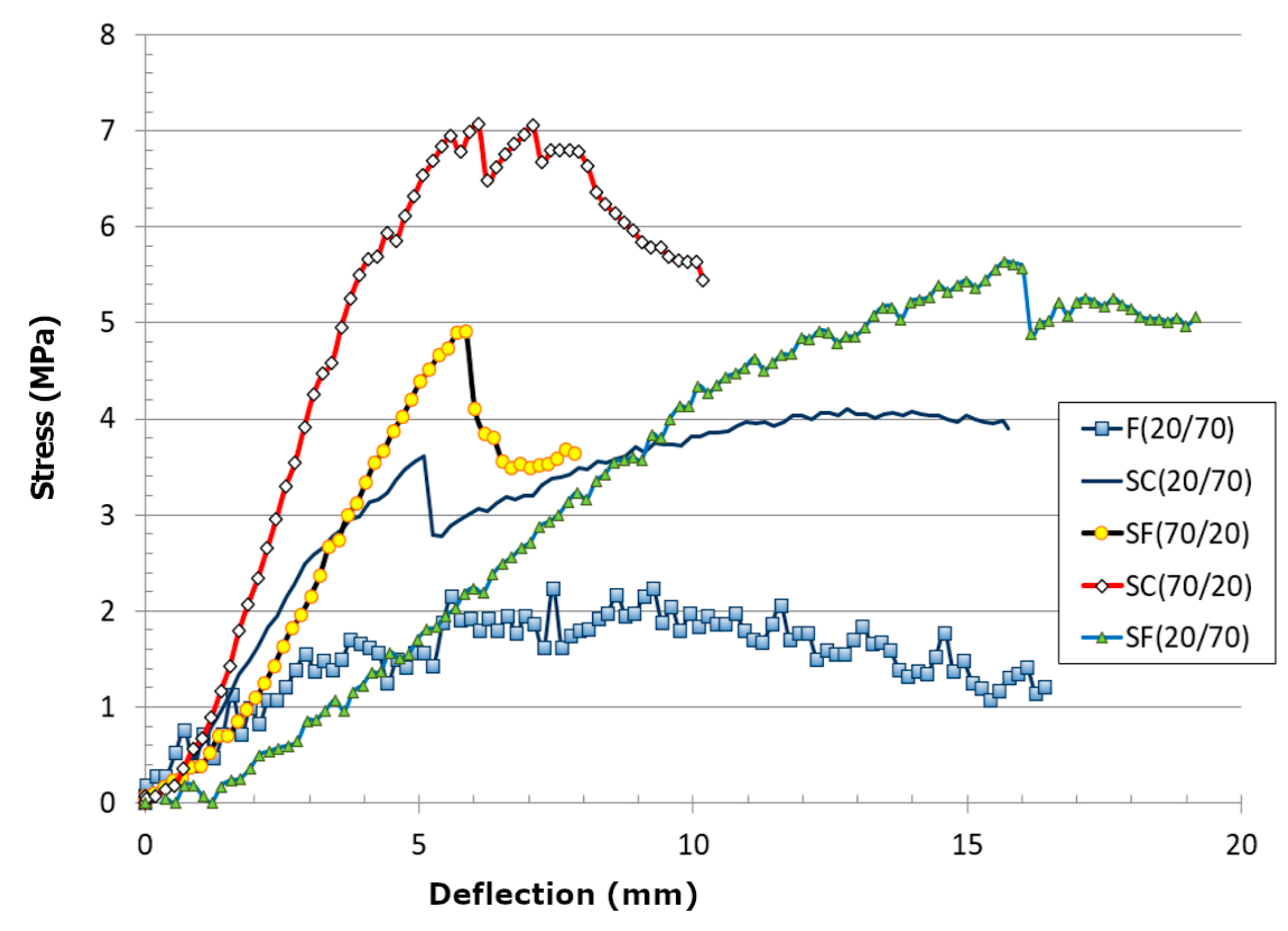
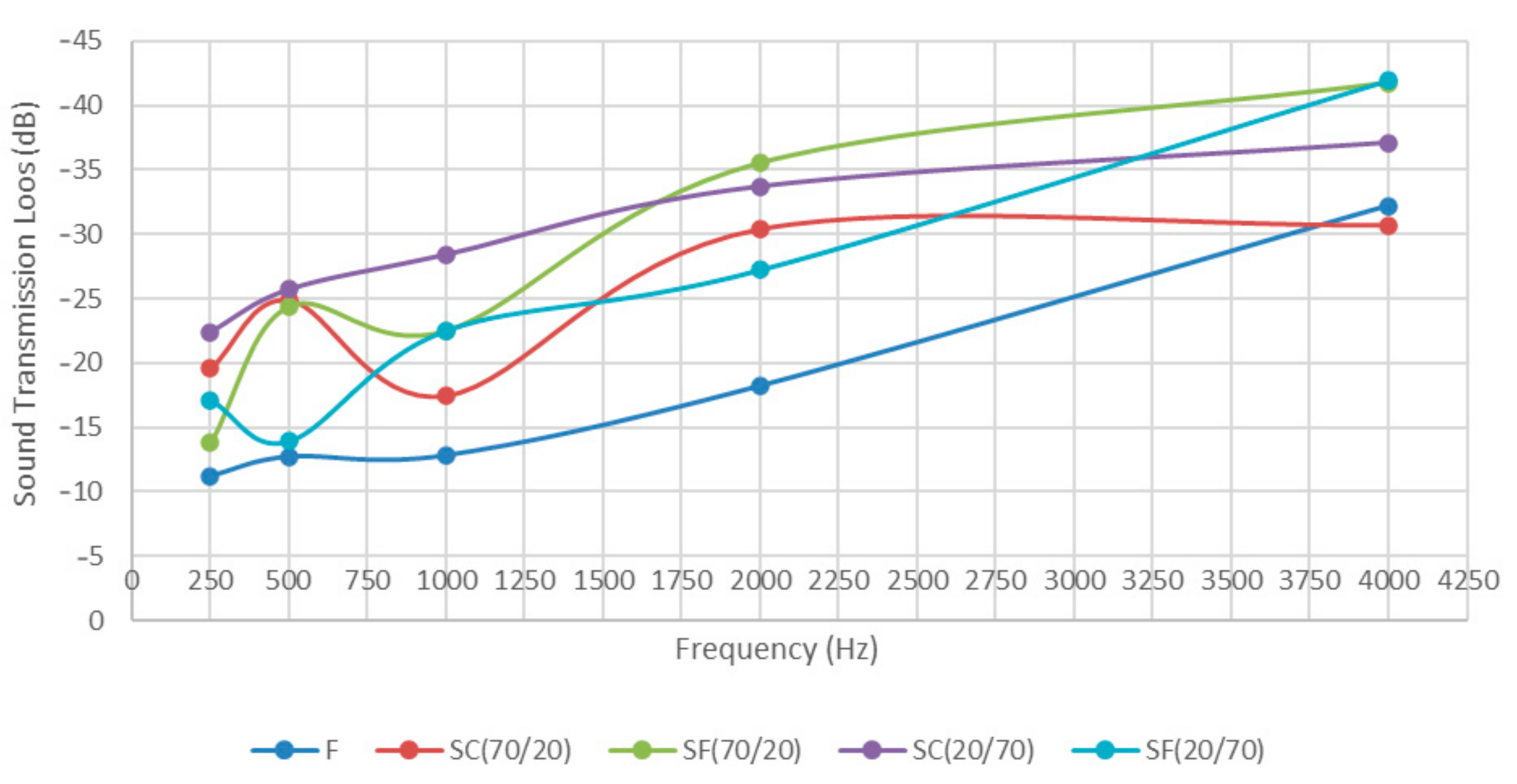
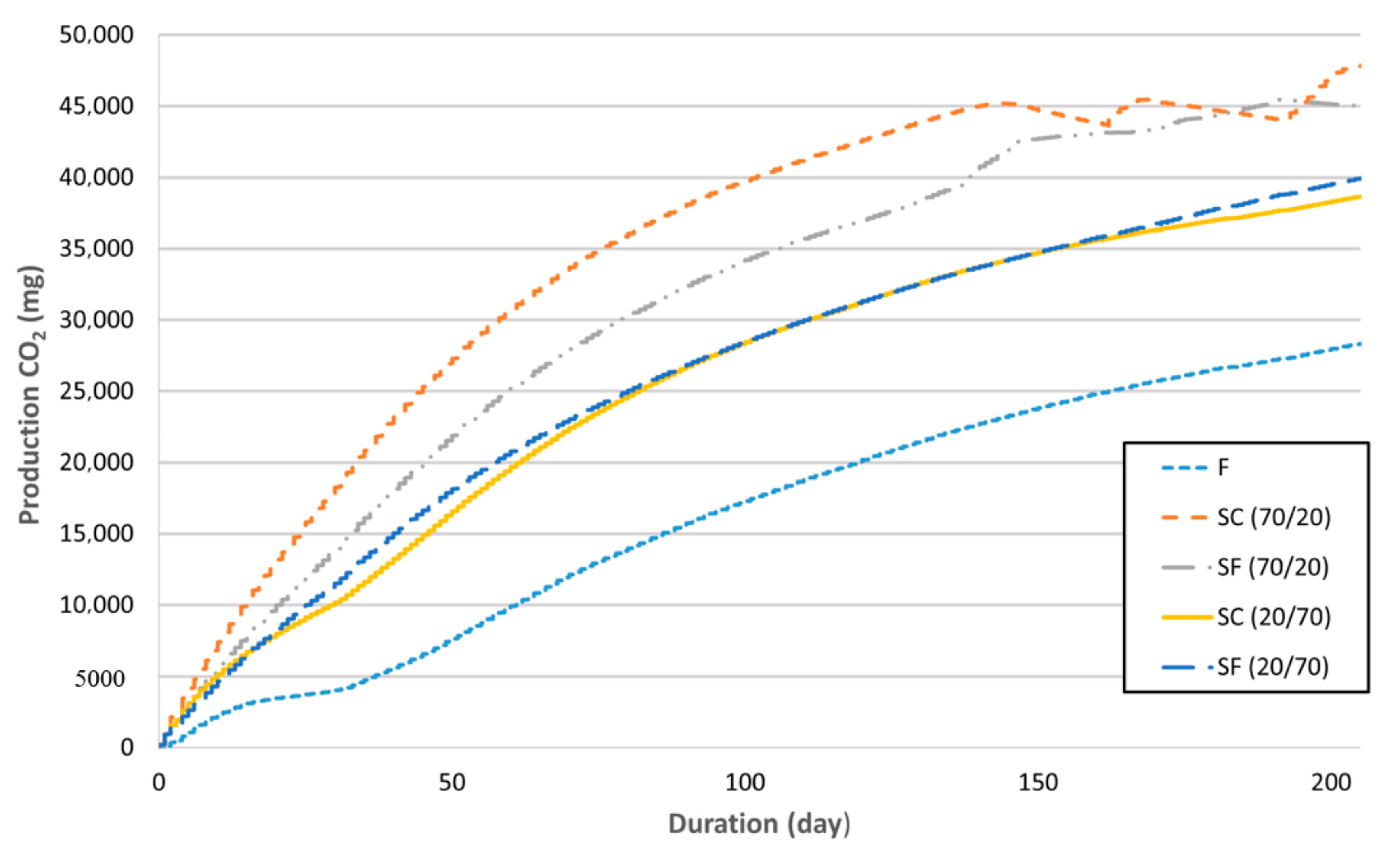
| Sample Denotation | Description | Feather Share (%) | Waste Wood Share (%) | Adhesive Share (%) | Density (kg/m3) |
|---|---|---|---|---|---|
| F | Blend Structure (Feathers/Mixed Wood Residues) | 20 | 70 | 10 | 485 |
| SC(70/20) | Sandwich Structure—Coarse (Feathers/Wood Shavings) | 70 | 20 | 10 | 632 |
| SF(70/20) | Sandwich Structure—Fine (Feathers/Mixed Wood Residues) | 70 | 20 | 10 | 653 |
| SC(20/70) | Sandwich Structure—Coarse (Feathers/Wood Shavings) | 20 | 70 | 10 | 734 |
| SF(20/70) | Sandwich Structure—Fine (Feathers/Mixed Wood Residues) | 20 | 70 | 10 | 619 |
| F | SC(70/20) | SF(70/20) | SC(20/70) | SF(20/70) | |
|---|---|---|---|---|---|
| λ (W/mK) | 0.18 | 0.11 | 0.13 | 0.14 | 0.15 |
| STD (W/mK) | 0.02 | 0.01 | 0.02 | 0.01 | 0.01 |
Publisher’s Note: MDPI stays neutral with regard to jurisdictional claims in published maps and institutional affiliations. |
© 2020 by the authors. Licensee MDPI, Basel, Switzerland. This article is an open access article distributed under the terms and conditions of the Creative Commons Attribution (CC BY) license (http://creativecommons.org/licenses/by/4.0/).
Share and Cite
Šafarič, R.; Fras Zemljič, L.; Novak, M.; Dugonik, B.; Bratina, B.; Gubeljak, N.; Bolka, S.; Strnad, S. Preparation and Characterisation of Waste Poultry Feathers Composite Fibreboards. Materials 2020, 13, 4964. https://doi.org/10.3390/ma13214964
Šafarič R, Fras Zemljič L, Novak M, Dugonik B, Bratina B, Gubeljak N, Bolka S, Strnad S. Preparation and Characterisation of Waste Poultry Feathers Composite Fibreboards. Materials. 2020; 13(21):4964. https://doi.org/10.3390/ma13214964
Chicago/Turabian StyleŠafarič, Riko, Lidija Fras Zemljič, Miroslav Novak, Bogdan Dugonik, Božidar Bratina, Nenad Gubeljak, Silvester Bolka, and Simona Strnad. 2020. "Preparation and Characterisation of Waste Poultry Feathers Composite Fibreboards" Materials 13, no. 21: 4964. https://doi.org/10.3390/ma13214964
APA StyleŠafarič, R., Fras Zemljič, L., Novak, M., Dugonik, B., Bratina, B., Gubeljak, N., Bolka, S., & Strnad, S. (2020). Preparation and Characterisation of Waste Poultry Feathers Composite Fibreboards. Materials, 13(21), 4964. https://doi.org/10.3390/ma13214964








